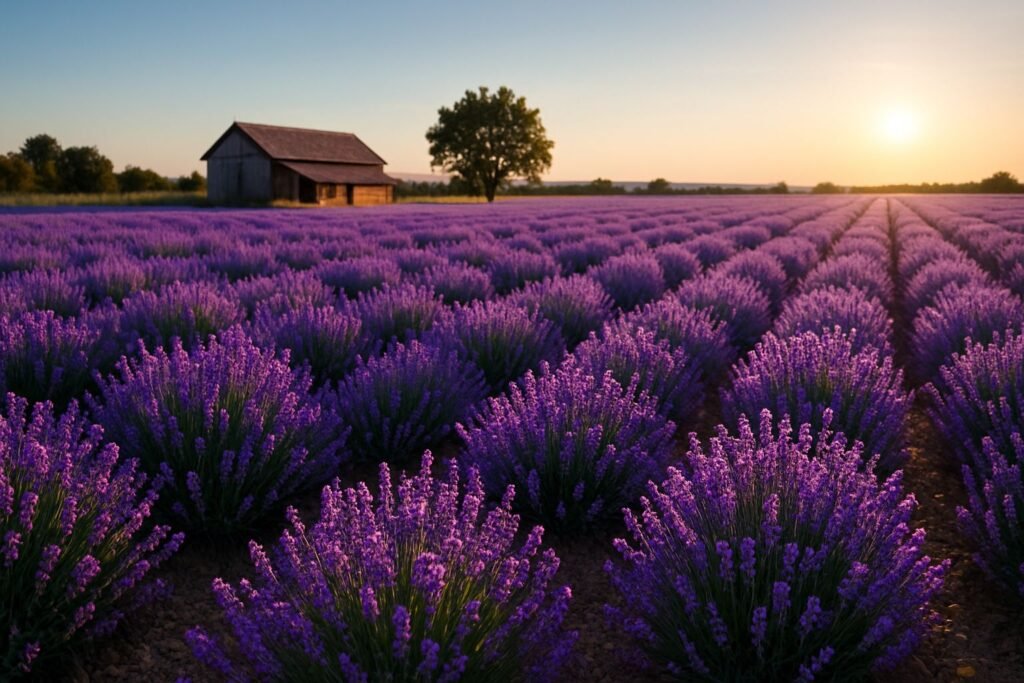
Introduction: Small Farm, Big Profit
In 2025, small-scale farming is no longer about surviving — it’s about thriving smartly. Across the United States, Canada, and parts of Europe, modern farmers are using innovation, niche crops, and direct-to-consumer sales to turn tiny plots into profitable ventures. The key? Choosing the right crops — ones that are high in market demand, require less space, and provide excellent return on investment (ROI). Whether you’re a new homesteader, a weekend grower, or an eco-conscious entrepreneur, this guide reveals the 10 most profitable crops that can transform your small farm into a revenue-generating powerhouse. We’ll go beyond just names — expect practical data, ROI breakdowns, visuals, and real-world insights for 2025.
Why Profitability Matters in Small Farming
Unlike large-scale farms with hundreds of acres, small farms rely heavily on efficiency and strategic crop selection. Every square foot counts. That’s why choosing profitable crops with high market demand, low growing costs, and fast turnover cycles is critical.
Additionally, climate change, resource limitations, and increasing consumer interest in organic and sustainable agriculture are reshaping the market. Small farmers who align their crop choices with these trends are thriving by selling directly to consumers via farmers markets, CSAs (Community Supported Agriculture), and online platforms.
Profitability in small farming isn’t just about income — it’s about sustainability, lifestyle, and long-term growth.
Comparison Table: Top 10 Profitable Crops Snapshot
| Crop | Avg. Yield/acre | Est. Profit/acre | Growing Season | Market Demand |
|---|---|---|---|---|
| Garlic | 10,000 lbs | $20,000+ | 6-7 months | High |
| Microgreens | Indoor trays | $25,000+ | Year-round | Very High |
| Mushrooms | 25 lbs/sq. ft | $15,000–$30,000 | Indoor | High |
| Saffron | 12–15 lbs/acre | $25,000+ | Seasonal | Premium niche |
| Lavender | 3,000 lbs | $8,000–12,000 | Summer | Growing |
| Gourmet Tomatoes | 20,000 lbs | $7,000–10,000 | Summer | Consistent |
| Bamboo | 40–60 tons | $10,000+ | Perennial | Sustainable trend |
| Ginseng | 1,000 lbs | $30,000+ | 5–7 years | Niche market |
| Hops | 2,000 lbs | $6,000–12,000 | Seasonal | Craft beer boom |
| Herbs (basil etc.) | Varies | $10,000+ | 3–4 cycles/yr | Steady |
1. Garlic – The High-ROI Crop That’s Easy to Grow
Garlic has long been a staple in global cuisines, but it’s also gaining ground as one of the most profitable crops for small-scale farmers in the West. Its popularity among health-conscious consumers, chefs, and organic markets makes it a premium cash crop. From a single acre, growers can produce up to 10,000 pounds of garlic, and if marketed well—especially as organic or heirloom varieties—the revenue can easily surpass $20,000 per acre.
Garlic is also relatively low-maintenance. It thrives in temperate climates, particularly in northern U.S. states and parts of Europe. The growing season begins in fall, allowing farmers to use their land year-round when rotating with summer crops. There are two main types: softneck garlic, which stores longer and is ideal for braiding, and hardneck garlic, which performs better in colder climates and offers complex flavor profiles that gourmet chefs love.
The storage and shelf-life of garlic make it easier to sell over time, unlike perishable vegetables. Dried, braided, or packaged garlic can be sold at local farmers’ markets, health food stores, and even through online platforms.
Interesting Fact: A study by the University of California Agriculture and Natural Resources found that hardneck garlic varieties grown in Northern California could yield a gross return of $24,000 per acre when sold directly to gourmet markets. The demand for organic garlic has increased by 12% annually in North America since 2020.
2. Microgreens – Fast-Growing Profits in Tiny Spaces
Microgreens are one of the fastest-growing and most profitable crops you can grow, especially in urban or indoor settings. These young vegetable greens, harvested just 7–14 days after germination, are packed with nutrients and flavor, making them highly desirable among chefs, foodies, and health-conscious consumers.
Since they can be grown vertically in trays, even a garage or small greenhouse can yield thousands of dollars worth of microgreens each month. A well-optimized setup with LED lights, shelves, and trays can produce over $25,000 per year from just 500 square feet of space. Popular varieties include sunflower, pea shoots, arugula, and radish.
Microgreens are a favorite for those starting out in sustainable agriculture due to their short turnaround time, low startup cost, and rapid ROI.
Interesting Fact: According to a 2024 study by the American Society for Horticultural Science, microgreens contain up to 40 times more nutrients than their mature counterparts, making them a “superfood” category in premium health food markets.
3. Mushrooms – A Dark Horse in Farm Profitability
Mushrooms, particularly gourmet varieties like oyster, shiitake, and lion’s mane, are a hidden gem in profitable crop farming. They can be grown indoors with controlled humidity and temperature, making them ideal for year-round production in garages, basements, or converted barns.
Yield per square foot is impressive: some varieties can produce 25 pounds per square foot per year, with income ranging from $15,000 to $30,000 annually depending on the scale. Since mushrooms don’t need sunlight or soil, they’re excellent for non-traditional growing spaces.
Local restaurants, farmers markets, and health food stores often pay premium prices for fresh, organic mushrooms.
Interesting Fact: A 2023 report by the National Mushroom Council revealed that the U.S. gourmet mushroom market grew by 18% in just one year, with lion’s mane and oyster mushrooms leading in consumer demand.
4. Saffron – The World’s Most Expensive Spice
Saffron, derived from the stigmas of the Crocus sativus flower, is often called “red gold” due to its extraordinary value. Although it requires labor-intensive harvesting (it takes around 75,000 flowers to produce a single pound), the market value of saffron easily justifies the effort. Prices range from $1,500 to $5,000 per pound, and even small plots can yield $25,000+ per acre.
This crop thrives in dry, sunny climates with well-draining soil and minimal rainfall, making it suitable for parts of California, Arizona, and Mediterranean Europe. It’s a perfect profitable crop for patient growers targeting gourmet and international markets.
Interesting Fact: Research published in the journal Industrial Crops and Products (2022) found that U.S.-grown saffron, particularly in Vermont and California, has equal or superior quality compared to Iranian imports, creating a new premium domestic market.
5. Lavender – Fragrance, Oil, and Profit

Lavender is a versatile crop used in cosmetics, essential oils, culinary products, and wellness items. Once established, lavender plants can live for 10+ years and require minimal irrigation. A single acre can produce up to 3,000 pounds of flowers, resulting in an estimated $8,000 to $12,000 in profit from dried bundles, oil extraction, and value-added products.
Its drought resistance and aesthetic appeal also make it popular for agritourism and on-farm experiences like U-pick fields and lavender festivals.
Interesting Fact: According to the University of Kentucky Horticulture Department, demand for lavender essential oil in the U.S. has increased by over 200% since 2018, driven by the natural wellness trend.
6. Gourmet Tomatoes – A Consistent Winner
Gourmet tomatoes like heirlooms, cherry, and specialty varieties are always in demand at farmers markets and upscale grocery stores. With good irrigation, soil fertility, and trellising, one acre can yield up to 20,000 pounds, translating to $7,000–$10,000 in profits.
Flavor-rich heirloom tomatoes sell at a premium and can be marketed as organic or pesticide-free. The growing season runs from late spring to early fall in most regions.
Interesting Fact: A 2023 USDA report showed that heirloom tomatoes fetched 2.5x more per pound than conventional types at farmers markets in urban areas.
7. Bamboo – The Sustainable Money Tree
Bamboo is one of the fastest-growing plants on Earth and has numerous commercial uses: furniture, flooring, textiles, and even edible shoots. Although it takes a few years to establish, once mature, bamboo can produce 40–60 tons per acre annually, earning $10,000+ with little maintenance. It’s a real profitable crop.
With growing demand for sustainable materials, eco-friendly builders and designers are increasingly turning to domestic bamboo sources.
Interesting Fact: A 2022 market study by Statista projected that the U.S. bamboo products market will reach $1.3 billion by 2027, doubling from 2021.
8. Ginseng – The Long-Term Investment Crop
Ginseng is prized in Asian medicine and wellness industries for its adaptogenic properties. Though it takes 5–7 years to reach maturity, the high market price (– $500–$700 per pound) makes it incredibly profitable, especially for forest farming.
Shade-grown ginseng in hardwood forests requires minimal inputs and benefits from sustainable harvesting techniques.
Interesting Fact: According to Penn State Extension, high-quality wild-simulated ginseng can fetch up to $30,000 per acre, especially in export markets like China and South Korea.
9. Hops – Brewing Up Farm Revenue
With the explosion of craft breweries across the U.S. and Europe, hops have become a highly sought-after crop. Although initial trellising and infrastructure are required, one acre can yield 2,000 pounds of hops, bringing in $6,000–$12,000 annually.
Hops grow best in temperate climates with lots of sunlight and good drainage. Farmers can contract directly with breweries or sell dried hops online.
Interesting Fact: The U.S. Department of Agriculture reported that the craft beer market now accounts for 27% of total beer sales, pushing demand for local hops higher each year.
10. Culinary Herbs – Small Space, Big Returns
Herbs like basil, parsley, thyme, cilantro, and mint are ideal for high-density planting and quick turnover. You can harvest multiple times a year and grow them in raised beds, greenhouses, or containers. One acre (or less) can yield $10,000+ annually, especially when selling fresh cut herbs to restaurants or CSA boxes.
Specialty herbs like holy basil, lemongrass, or chives command even higher prices in niche markets.
Interesting Fact: According to the American Herbal Products Association, retail herb sales in North America surpassed $10 billion in 2024, with culinary herbs being a top contributor.
Expert Tips for Small Farm Profitability
- Start small and validate demand locally
- Focus on quality, not just quantity
- Add value through drying, packaging, or productizing
- Use drip irrigation and organic pest control to reduce costs
- Build a loyal customer base via social media and newsletters
FAQs
Q: Can I grow these crops organically?
Yes, most of them can be grown organically and may command higher prices if certified.
Q: What are the best crops for beginners?
Microgreens, garlic, and herbs are ideal due to low setup costs and faster results.
Q: How do I find buyers for these crops?
Use local farmers markets, CSA programs, restaurants, and online platforms like Etsy or Shopify.
Conclusion
Small-scale farming is no longer just a side hustle — it can be a lucrative, fulfilling, and eco-friendly way to earn a living. The crops listed above prove that with the right choices, even a single acre can generate substantial income.
Whether you’re planning your first season or scaling up your operations, choose a crop that matches your environment, skills, and passion. Want to go deeper? Subscribe to our newsletter for crop trends, success stories, and free guides!
Useful Link:
- FAO – Food and Agriculture Organization of the United Nations
https://www.fao.org
→ Global insights on high-value crops, climate adaptation, and sustainable farming
To know more about Agro Reality, Click here
Pingback: How to Start Garlic Farming in the USA: A Complete Beginner’s Guide (2025) - Agro Reality